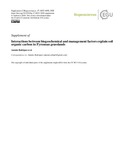Mostrar el registro sencillo del ítem
Interactions between biogeochemical and management factors explain soil organic carbon in Pyrenean grasslands
| dc.creator | Rodríguez, Antonio | es_ES |
| dc.creator | Canals Tresserras, Rosa María | es_ES |
| dc.creator | Plaixats Boixadera, J. | es_ES |
| dc.creator | Albanell, E. | es_ES |
| dc.creator | Debouk, Haifa | es_ES |
| dc.creator | Garcia-Pausas, Jordi | es_ES |
| dc.creator | San Emeterio Garciandía, Leticia | es_ES |
| dc.creator | Ribas, A. | es_ES |
| dc.creator | Jiménez, Juan José | es_ES |
| dc.creator | Sebastià, M.T. | es_ES |
| dc.date.accessioned | 2021-06-23T06:38:03Z | |
| dc.date.available | 2021-06-23T06:38:03Z | |
| dc.date.issued | 2020 | |
| dc.identifier.issn | 1726-4170 | |
| dc.identifier.uri | https://hdl.handle.net/2454/40011 | |
| dc.description | Incluye material complementario | es_ES |
| dc.description.abstract | Grasslands are one of the major sinks of terrestrial soil organic carbon (SOC). Understanding how environmental and management factors drive SOC is challenging because they are scale-dependent, with large-scale drivers affecting SOC both directly and through drivers working at small scales. Here we addressed how regional, landscape and grazing management, soil properties and nutrients, and herbage quality factors affect 20 cm depth SOC stocks in mountain grasslands in the Pyrenees. Taking advantage of the high variety of environmental heterogeneity in the Pyrenees, we built a dataset (n = 128) that comprises a wide range of environmental and management conditions. This was used to understand the relationship between SOC stocks and their drivers considering multiple environments. We found that temperature seasonality (difference between mean summer temperature and mean annual temperature; TSIS) was the most important geophysical driver of SOC in our study, depending on topography and management. TSIS effects on SOC increased in exposed hillsides, slopy areas, and relatively intensively grazed grasslands. Increased TSIS probably favours plant biomass production, particularly at high altitudes, but landscape and grazing management factors regulate the accumulation of this biomass into SOC. Concerning biochemical SOC drivers, we found unexpected interactive effects between grazer type, soil nutrients and herbage quality. Soil N was a crucial SOC driver as expected but modulated by livestock species and neutral detergent fibre contenting plant biomass; herbage recalcitrance effects varied depending on grazer species. These results highlight the gaps in knowledge about SOC drivers in grasslands under different environmental and management conditions. They may also serve to generate testable hypotheses in later/future studies directed to climate change mitigation policies. | en |
| dc.description.sponsorship | Research in this paper is based on the PAS-TUS Database, which was compiled from different funding sources over time, the most relevant being the EU Interreg III-A Programme (I3A-4-147-E) and the POCTEFA Programme/Interreg IV-A (FLUXPYR, EFA 34/08); the Spanish Science Foundation FECYT-MICINN (CARBOPAS: REN2002-04300-C02-01; CAR-BOAGROPAS: CGL2006-13555-C03-03 and CAPAS: CGL2010-22378-C03-01); and the Foundation Catalunya-La Pedrera and the Spanish Institute of Agronomical Research INIA (CARBO-CLUS: SUM2006-00029-C02-0). Leticia San Emeterio was funded through a Talent Recruitment grant from Obra Social La Caixa- Fundación CAN. The ARAID Foundation provided support to Juan José Jiménez. This work was funded by the Spanish Science Foundation FECYT-MINECO (projects BIOGEI: GL2013-49142-C2-1-R and IMAGINE: CGL2017-85490-R) and the University of Lleida (PhD Fellowship to Antonio Rodríguez). | |
| dc.format.extent | 18 p. | |
| dc.format.mimetype | application/pdf | en |
| dc.language.iso | eng | en |
| dc.publisher | Copernicus | |
| dc.relation.ispartof | Biogeosciences, 17, 6033–6050, 2020 | |
| dc.rights | © Author(s) 2020. This work is distributed under the Creative Commons Attribution 4.0 License. | en |
| dc.rights.uri | http://creativecommons.org/licenses/by/4.0/ | |
| dc.subject | Soil organic carbon (SOC) | en |
| dc.subject | Pyrenees | en |
| dc.subject | Grasslands | en |
| dc.subject | Grazing | en |
| dc.subject | Temperature seasonality (TSIS) | en |
| dc.title | Interactions between biogeochemical and management factors explain soil organic carbon in Pyrenean grasslands | en |
| dc.type | info:eu-repo/semantics/article | en |
| dc.type | Artículo / Artikulua | es |
| dc.contributor.department | Institute on Innovation and Sustainable Development in Food Chain - ISFOOD | es_ES |
| dc.contributor.department | Agronomía, Biotecnología y Alimentación | es_ES |
| dc.contributor.department | Agronomia, Bioteknologia eta Elikadura | eu |
| dc.rights.accessRights | info:eu-repo/semantics/openAccess | en |
| dc.rights.accessRights | Acceso abierto / Sarbide irekia | es |
| dc.identifier.doi | 10.5194/bg-17-6033-2020 | |
| dc.relation.projectID | info:eu-repo/grantAgreement/MINECO//CGL2013-49142-C2-1-R/ES/ | en |
| dc.relation.projectID | info:eu-repo/grantAgreement/AEI/Plan Estatal de Investigación Científica y Técnica y de Innovación 2013-2016/CGL2017-85490-R/ES/ | en |
| dc.relation.publisherversion | https://doi.org/10.5194/bg-17-6033-2020 | |
| dc.type.version | info:eu-repo/semantics/publishedVersion | en |
| dc.type.version | Versión publicada / Argitaratu den bertsioa | es |




